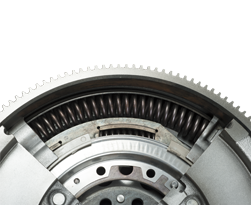Clutch release cylinders (C.R.C.)

Along with technologies and new car manufacturers’ requirements, it has become difficult to fit a cable in a straight line between the pedal and the lever. That’s why more and more cars are now using hydraulics systems. These are much more flexible and reliable compared to manual systems. First, they enable an optimal and constant pedal effort. Second, the used material is much lighter (up to 70% reduction of weight compared to the standard clutch system command) as well as much more compact. This is the main reason why this technology is easier to implement on OE projects.
As an answer to this market trend, Valeo has developed a wide range of hydraulic parts: clutch master cylinder (CMC), clutch release cylinder(CRC) and clutch slave cylinder (CSC). Both the clutch master cylinder and the clutch release cylinder are used in “semi-hydraulic” system, whereas “full hydraulic” system uses the CMC and the CSC. The “semi-hydraulic” system consists of a transmitter (the C.M.C.), a hose and a receiver. For this system, the receiver is a C.R.C. Valeo’s range is composed of over 55 part numbers, covering applications such as Fiat Punto, Ford Transit, Hyundai Accent, Kia Picanto. In a “semi hydraulic” system, the clutch pedal arm operates a piston in the clutch master cylinder (CMC).
This action forces hydraulic fluid through a pipe to the clutch release cylinder (CRC) where another piston operates the clutch disengagement mechanism. Each time the vehicle is equipped with a CRC, the interface within the hydraulic system and the clutch is done with a clutch fork and a release bearing. Contrary to the CSC (in full hydraulic system), the CRC is very easy and quick to replace as it is always located outside the transmission housing. The gearbox does not need to be removed to replace the part. That is why it is easy and quick to replace the hydraulic components without removing the gearbox. Replacing a CRC takes around 30 minutes for professionals.







